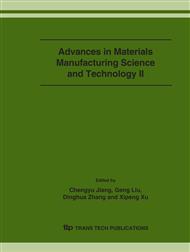p.632
p.636
p.640
p.644
p.648
p.653
p.657
p.661
p.665
Damage Analysis of Particulate Polymer Composites Based Structure by Using Micro-Meso-Macro Finite Element Approach
Abstract:
A micro-meso-macro finite element approach has been developed for simulating the macro-scale damage coupled deformation in a particulate polymer composite (PPC) based structure under tension. A damage model for the PPC structure was developed to define the debonding damage behavior of the structure. The computational results determined in our previous studies by using finite element meso-cell modeling technique were used as the input parameters of the damage model and definition of the constitutive behavior of PPC. A user-defined subroutine VUMAT describing the damage-coupled constitutive behaviour of PPC for defining the material properties of the finite elements for the structure was then built and incorporated into the ABAQUS finite element code. A case example has been given to demonstrate the proposed approach. The macroscale damage process in the simulated component was found to be reasonable.
Info:
Periodical:
Pages:
648-652
Citation:
Online since:
December 2006
Price:
Сopyright:
© 2006 Trans Tech Publications Ltd. All Rights Reserved
Share:
Citation:


